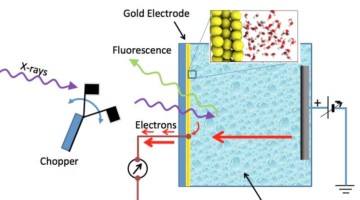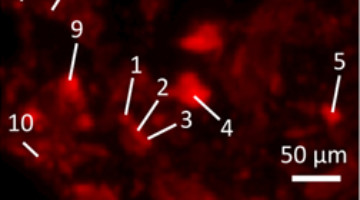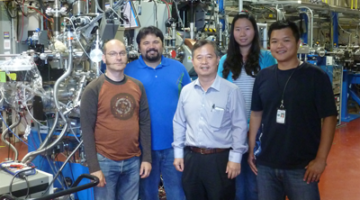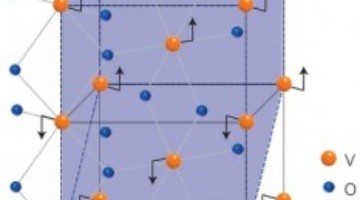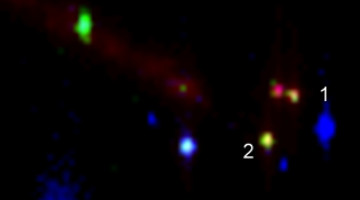Recently a team of Stanford and Berkeley Lab researchers used x-rays at the ALS in a novel way to observe the behavior of electrons during technologically important chemical reactions in metal oxide electrocatalysts. What they learned has upended long-held scientific understanding of how these catalysts work. Read more »![]()
![]()
ALS Work Using XAS
In x-ray absorption spectroscopy (XAS), the incident x-ray energy is tuned over a range that will excite core-level electrons. Sharp increases in absorption occur at specific energies, characteristic of the absorbing element. The resulting spectra probe the elemental composition as well as the chemical and electronic structure of the material.
Molecular Structure of Water at Gold Electrodes Revealed
ALS researchers have now made a first-ever observation of the molecular structure of liquid water at a gold surface under different charging conditions. This marks the first time that the scientific community has been able to achieve such high sensitivity in an in situ environment under working electrode conditions. Read more »![]()
![]()
Infrared Mapping Helps Optimize Catalytic Reactions
A pathway to more effective and efficient synthesis of pharmaceuticals and other flow-reactor chemical products has been opened by a study in which, for the first time, the catalytic reactivity inside a microreactor was mapped in high resolution from start to finish. Read more »![]()
![]()
Iron is the Key to Preserving Dinosaur Soft Tissue
Researchers studying organic material from dinosaur bones have been able to show that the samples contained original soft tissue material from Mesozoic dinosaurs. The x-ray techniques at the ALS were key to showing a possible mechanism for this unexpected preservation.
Read more »![]()
![]()
Toyota Collaborates with the ALS and Molecular Foundry
Toyota has been working at the ALS for a few years now to gain deeper insight into the chemistry of electrolytes for use in magnesium-ion batteries. The hope is that the research eventually leads to a fully developed magnesium-based battery technology that would replace lithium-ion batteries with essentially twice the energy in the same volume. Toyota hopes to move toward this goal more quickly through a new collaborative research project at the ALS and the Molecular Foundry. Read more »
IBM Probes Material Capabilities at the ALS
Vanadium dioxide, one of the few known materials that acts like an insulator at low temperatures but like a metal at warmer temperatures, is a somewhat futuristic material that could yield faster and much more energy-efficient electronic devices. Researchers from IBM’s forward-thinking Spintronic Science and Applications Center (SpinAps) recently used the ALS to gain greater insight into vanadium dioxide’s unusual phase transition. Read more »![]()
![]()
Particles from Comet 81P/Wild 2 Viewed by ALS Microscopes
NASA’s $200-million, seven-year-long Stardust mission returned to Earth thousands of tiny particles snagged from the coma of comet 81P/Wild 2. Four ALS beamlines and the researchers using them were among the hundreds of scientists and dozens of experimental techniques in facilities around the world that contributed to the preliminary examination of the first samples.
Read more »![]()
![]()
- « Previous Page
- 1
- …
- 7
- 8
- 9
